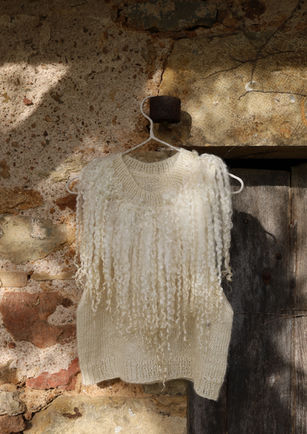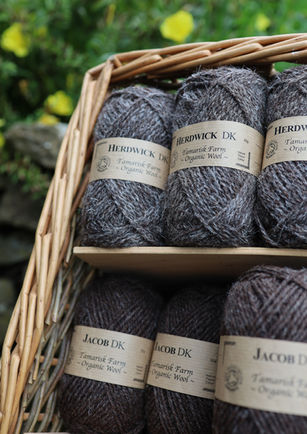
Fashion and agriculture are among the industries with the highest climate footprint – through over consumption
of finite resources, aggregated CO2 emissions, widespread ecosystem pollution and resulting extensive
biodiversity loss.
This design-led R&D partnership between researchers from Centre for Sustainable Fashion, South East England Fibreshed and South West England Fibreshed supports Fibreshed’s mission to revalue UK wool and create short, transparent bio-regional fibre and fashion supply networks with potential for replication. Wool is still produced in the UK in abundance, but it is chronically undervalued, underutilised and often destroyed through lack of markets.
The project addresses one of the key barriers for advancement of bio-regional fibre and textiles ecosystems and economies - the lack of links, common language and mutual understanding of requirements and production cycles between farmers, designers and processors.
Project Aims
1. Advance the understanding of properties and biodiversity benefits of bio-regional native and rare breed wool production in the South East England (SEE) and South West England (SWE) and beyond, through the pilot implementation of SEE & SWE Fibresheds’ new Farming Fashion: Wool guide.
2. Develop experimental design prototypes that embody the experience of ‘wearing the landscape’, providing a tangible proof-of-concept that can facilitate access to further R&D and funding for farmers and designers.
3. Facilitate future innovation and collaboration opportunities for farmers, designers, and processors of fibre and textiles through improved mutual understanding of requirements and production cycles when working with local landscapes, animals and natural rhythms.
Future Fashion Landscapes
Fostering biodiversity through collaborations between farmers, designers, and processors of native and rare breed wool.

Project Outputs
In response to the project aims, and building upon relationships developed by SEE and SWE Fibresheds, we have:
1. Connected currently disconnected communities, through new contacts, collaborations, and collaboration
networks/ecosystems.
Improved mutual understanding of requirements and production cycles between farmers, designers and processors.
Increased confidence to respond to or approach each other between farmers, designers and processors
-
Supported 4 in-person meetups of farmers and designers convened and facilitated by SEE and SWE Fibresheds, with workshop activities and introduction of the Farming Fashion: Wool Guide: Bristol – Bristol Textile Quarter; Fernhill Farm – Mendip Hills (as part of Sustainable Fashion Week); London – Cockpit Arts; Sussex – Ticehurst
-
Co-hosted and coordinated a farmer/designer meetup in Oxford (as part of Oxford Real Farming Conference parallel programme)
-
2 designer webinars including farmer and designer presentations + comprehensive presentation of the Farming Fashion: Wool guide
-
2 Farming Fashion: Wool guide presentations and workshops – Future Fabrics Expo, London; Groundswell – Regenerative agriculture festival, Lannock Farm, Hertfordshire.
2. Developed innovative design and comms prototypes that act as a proof of concept to facilitate better access to
future R&D and funding.
Advanced visibility and understanding of the properties and biodiversity benefits of local native breed wool for all beneficiaries, including industry and general public.
Evidenced successful partnerships between farmers and designers, including challenges, opportunities, and future steps for advancing bio-regional native breed wool ecosystems.
-
4 farmer-designer collaboration case studies (2 x per SW and 2 x per SE region):
Ria Burns Knitwear x Tamarisk Farm (Jurassic Coast, Dorset), Amelia Brown Knitwear x Fernhill Farm (Mendip Hills National Landscape, Sommerset); Phoebe English & Fabienne Gassmann
x Plaw Hatch Farm (Ashdown Forest, East Sussex), Elwin Studio x Chilton Grounds Farm (Aylesbury Vale, Oxfordshire) -
3 farmer-designer collaboration commitments, extending beyond the duration of the project: Ria Burns Knitwear x Tamarisk Farm (Jurassic Coast, Dorset), Amelia Brown Knitwear x Fernhill Farm (Mendip Hills National Landscape, Sommerset); Elwin Studio x Chilton Grounds Farm (Aylesbury Vale, Oxfordshire)
-
2 additional R&D partnerships resulting from project networking events
-
4 student team projects (4 x 5 students) responding to our ‘Wearing the Landscape’ storytelling brief.
3. Enabled immersive and hybrid learning opportunities for designers, farmers, students, the project partnership.
-
2 LCF MA student group visits to the biodynamic, community-owned, Demeter certified Plaw Hatch farm
-
5 in-person farmer-designer meetups including a guided tour of Fernhill Farm - certified regenerative under A Greener World and Savory Institute’s Land to Market scheme.
Explore
The Lissome, Issue No. 5, 'Rise Up, Rooted Like Trees'
The Lissome's latest issue features an editorial and photography series by Dr Mila Burcikova, ‘Future Fashion Landscapes’, illustrating the project's collaborative bioregional journey into wool, design and regenerative farming.
'Tomorrow’s Wardrobe' Exhibition | The Design Museum | Now Until August 2025
This free Future Observatory exhibition features contributions from the Future Fashion Landscapes project and collaboration with SEE and SWE Fibreshed. It brings together diverse designers who are revolutionising how we create, make, and wear clothes.

Project Team
-
Dr. Mila Burcikova, Reader in Fashion Systems, Centre for Sustainable Fashion
-
Deborah Barker, FRSA, Director of South-East England Fibreshed
-
Emma Hague, Director of South-West England Fibreshed
-
Prof. Sandy Black, Professor of Fashion and Textile Design and Technology, Centre for Sustainable Fashion
Funder
Funded by the Arts and Humanities Research Council (AHRC), part of UK Research and Innovation.
This project is part of The Design Museum's
Contact for the project
Dr. Mila Burcikova, Reader in Fashion Systems,
Centre for Sustainable Fashion
Email: m.burcikova@arts.ac.uk









